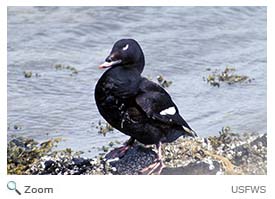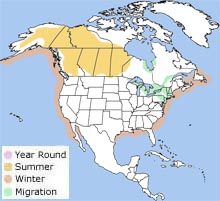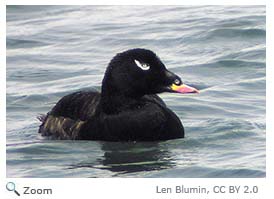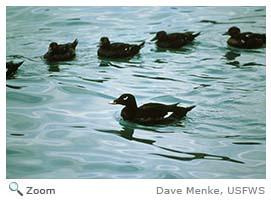Description
 White-winged scoters are large and stocky birds, measuring about 21 inches in length. They are among the largest of all ducks. Males are all black, with a white, comma-shaped patch around each eye. Females may have whitish patches on the face and are a dark brown color. The male's bill is black at the base with reddish sides and an orange nail. The female's bill is similar in color but less bright. Both males and females have red legs and a white stripe on their wings. White-winged scoters are large and stocky birds, measuring about 21 inches in length. They are among the largest of all ducks. Males are all black, with a white, comma-shaped patch around each eye. Females may have whitish patches on the face and are a dark brown color. The male's bill is black at the base with reddish sides and an orange nail. The female's bill is similar in color but less bright. Both males and females have red legs and a white stripe on their wings.
Range  The white-winged scoter has a wide range. Its summer breeding grounds extend from Alaska into Central Canada. During migration, it can be found around the Great Lakes. It spends its winters along the west and east coast of North America. The white-winged scoter has a wide range. Its summer breeding grounds extend from Alaska into Central Canada. During migration, it can be found around the Great Lakes. It spends its winters along the west and east coast of North America.
|
|
Habitat
 During the breeding season, white-winged scoters can be found in a variety of habitats. These include wooded coastlines, small freshwater lakes and rivers in northern coniferous forests, wooded arctic tundra and alpine zones. In the winter, white-winged scoters inhabit coastal waters, preferring estuaries and inlets with large mussel beds. During the breeding season, white-winged scoters can be found in a variety of habitats. These include wooded coastlines, small freshwater lakes and rivers in northern coniferous forests, wooded arctic tundra and alpine zones. In the winter, white-winged scoters inhabit coastal waters, preferring estuaries and inlets with large mussel beds.
Diet
 A diving duck, the white-winged scoter feeds on the bottom of lakes and oceans. Their diet consists mostly of mollusks, such as clams and mussels. Scoters will also eat crustaceans, worms, echinoderms, amphipods, isopods and small fish. In freshwater habitats, white-winged scoters will also feed on adult and larval insects and plant material. A diving duck, the white-winged scoter feeds on the bottom of lakes and oceans. Their diet consists mostly of mollusks, such as clams and mussels. Scoters will also eat crustaceans, worms, echinoderms, amphipods, isopods and small fish. In freshwater habitats, white-winged scoters will also feed on adult and larval insects and plant material.
Life Cycle
Breeding begins in mid-May. Females make a shallow depression on the ground for their nest. They prefer a site with tall grass, among hummocks or under bushes. They line the nest with sticks and down. Nests are close to the water.
White-winged scoters lay 6-16 creamy buff or light pink eggs per female. Chicks hatch with downy feathers and their eyes open. They leave their nests as soon as they're dry and are able to feed themselves immediately.
Behavior
The population of white-winged scoters on the Great Lakes is rising due to the growing population of the invasive zebra mussel. |


 The white-winged scoter has a wide range. Its summer breeding grounds extend from Alaska into Central Canada. During
The white-winged scoter has a wide range. Its summer breeding grounds extend from Alaska into Central Canada. During 
